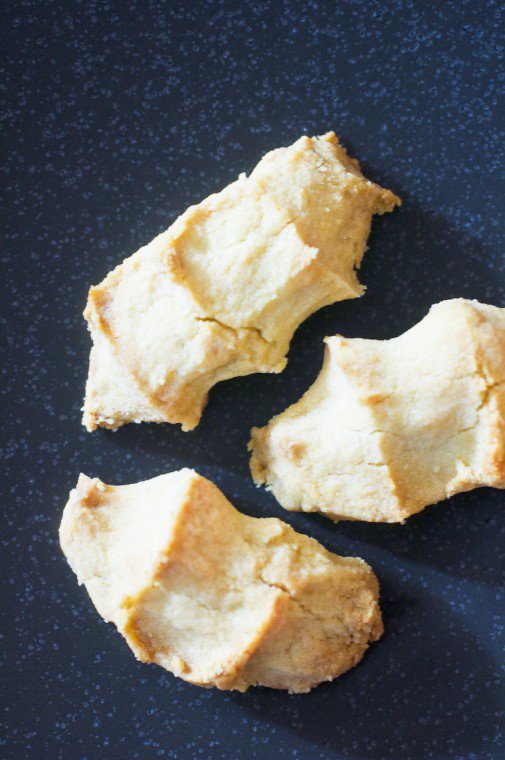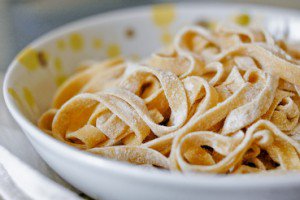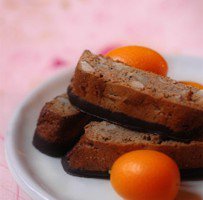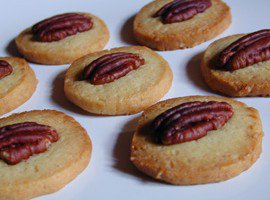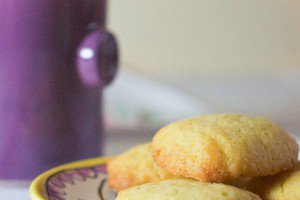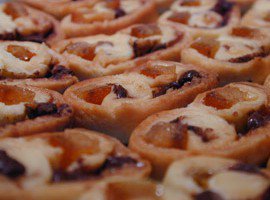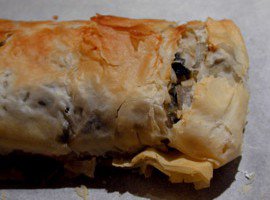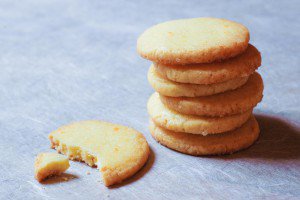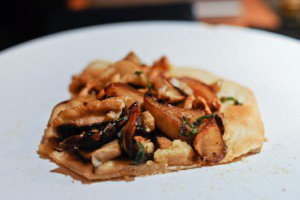Among the many things I learned during that memorable conference on molecular gastronomy, one idea has been whirling around my brain with particular insistence since then, and it is that of farine torréfiée*, or roasted flour.
It was introduced to us by way of a truism: raw flour is bland, browned flour isn’t. This is why we bother to make roux, and why the crust of bread is tastier than the crumb. With this simple fact in mind, why not bake with roasted flour? The finished product would no doubt benefit from the heightened flavor.
Of course, exposing flour to direct heat cooks it. This changes the structure of its starch and gluten molecules, and therefore it behaves differently from raw flour; one notable change is that it loses some of its elasticity. Consequently, the primary use Hervé This suggested for roasted flour is in sablés, i.e. cookies with a crumbly, sandy consistency, for which a weak gluten network is desirable.
I found a recipe for sablés à la farine torréfiée on Pierre Gagnaire’s website** and it looked exciting (it uses cooked egg yolks! exciting!) but for my first roasted flour experiment, I was more curious to alter my — or, should I say, my mother’s — basic recipe for sablés.
I did follow Gagnaire’s instructions to roast the flour, and after just a few minutes I could tell that this was going very well: already my kitchen smelled like the bakery around the corner***. When the flour had cooled and I used it to make the sablé dough, however, I realized it would not come together as obligingly as it normally does, but seemed rather to wish to remain a mound of sand.
I sensed that adding more butter would do the trick, but I like the moderate butter content of my mother’s recipe (most call for equal weights of butter and flour) so I proceeded as planned, and tried to form the dough into lumps however I could. The easiest (and most fun) way was to just squeeze it by the handful, a technique that resulted in these odd-shaped cookies I naturally decided to call squeeze cookies.
I find their funky look endearing, but if you’re worried that someone in your household (and I’m not naming names) might liken them to slugs or caterpillars, you can also shape them into balls, or pucks, or pack the dough in an even layer in a pan, following the instructions in this shortbread recipe.
More important than the shape, you’ll agree, is the flavor: I deliberately omitted any sort of flavor booster (vanilla, spices, citrus zest…) the better to judge the effect of the roasted flour, and I’m not afraid to say the effect is absolutely wowing. In fact, the same person who was so full of gastropod metaphors declared them the best sablés I’d ever made.
Grilled notes of chocolate and hazelnut come through in every bite, the consistency is a fine crumbliness unlike that of any sablé I know, and all that comes from a simple twenty-minute roasting step. See how the baking horizon has suddenly broadened? Don’t you have a favorite baking recipe you should be experimenting with, right this minute?
~~~
* The French term torréfier (to torrefy) has a slightly different meaning from rôtir (to roast) but has, to my knowledge, no exact equivalent in English. Torréfier is defined as “exposing to intense heat until the early stage of carbonization.” The most frequent use of the term — and the process — is the roasting of green, raw coffee beans, which turns them into a browned, intensely fragrant version of themselves.
** Pierre Gagnaire and Hervé This engage in a monthly conversation (in French, of course) wherein the scientist explores a chemical or physical phenomenon and the chef offers a recipe to illustrate it.
*** They say you should bake a loaf of bread before people come to visit the house you’re trying to sell, but, as it turns out, just roasting some flour should do the trick.

Have you tried this? Share your pics on Instagram!
Please tag your pictures with #cnzrecipes. I'll share my favorites!
Ingredients
- 150 g (1 1/4 cup) all-purpose flour (I used organic T65 flour)
- 75 g (1/3 cup) sugar
- 1/2 teaspoon salt flakes (fleur de sel, kosher salt, crushed Maldon...)
- 75 g (6 tablespoons) chilled unsalted butter, diced
- 1 egg yolk
- 1 to 3 tablespoons milk
Instructions
- Preheat the oven to 160°C (320°F). Spread the flour evenly on a rimmed cookie sheet and put in the oven to toast for 20 minutes, until fragrant, stirring the flour around every 5 minutes or so. (It may become lightly golden in places, but it should not change color overall.) Remove from the oven and let cool completely on the cookie sheet. This will take about an hour; you can toast the flour in advance and keep it in a jar.
- Combine the toasted flour, sugar, and salt in the bowl of a food processor. Add the diced butter and process until the mixture forms fine crumbs. Add the yolk and 1 tablespoon milk, and process in short pulses until the mixture clumps together when you squeeze it in your hand. If it is still too dry, add a little more milk. (The dough can also be mixed by hand, using the tips of your fingers or a wire pastry blender. Handle the dough as lightly as you can.)
- Line a baking sheet (one that fits in your fridge) with parchment paper. Take a small handful of the dough and squeeze it in your hand to form the shape you prefer -- either the simple "squeeze cookie" shape or a slightly flattened ball -- and place it on the prepared baking sheet. Chill for 1 hour.
- Preheat the oven to 180°C (360°F). Slip into the oven and bake for 15 minutes, keeping a close eye on them, until they're golden at the edges. Let rest on the sheet for 5 minutes then transfer to a rack to cool completely.
This post was first published in April 2008 and updated in July 2016.


